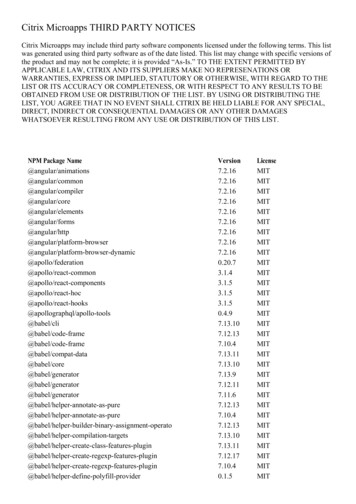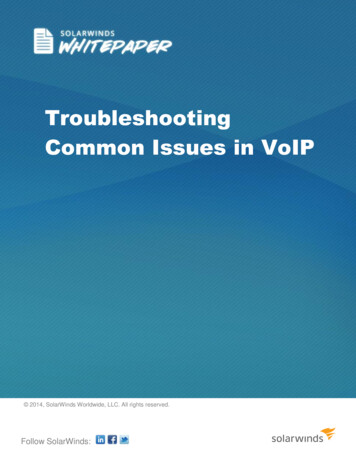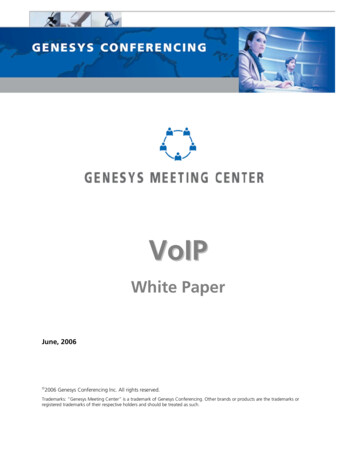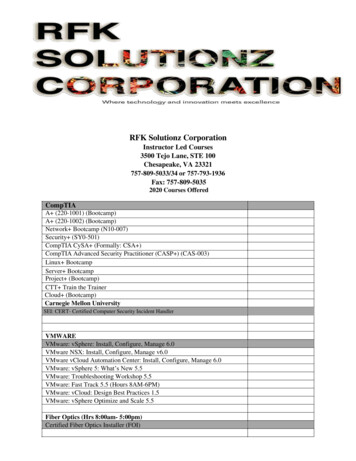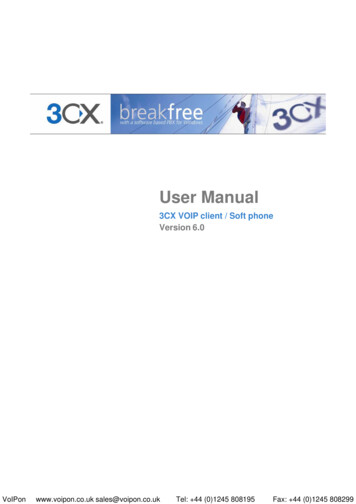
Transcription
VoIP at MITMerit VoIP SeminarDennis BaronApril 3, 2008np163Dennis Baron, April 3, 2008Page 1
Outline MIT VoIP Project Goals VoIP Service Models VoIP Architecture Rollout Plan Outstanding Issues Quick Questionsnp163Dennis Baron, April 3, 2008Page 2
Voice over IP Project Goals Smoothly migrate MIT to Voice over IP (VoIP) with minimalimpact to the end user community; determine optimal timingfor the transition Highly robust, carrier class infrastructure Roll-out plan developed in coordination with departments,labs, and centers:– site surveys of existing telephony services– scheduled migration Deployment support models from intensive & local hands-onby IS&T to cooperative support for DLC IT staff.np163Dennis Baron, April 3, 2008Page 3
Voice over IP Service Model Provide a flexible infrastructure for MIT faculty, students,and staff.– MITvoip managed enterprise service for most users Focus on desktop phone replacement Robust, reliable, and secure Scalable and supportable Voice only service– PersonalSIP accounts for everyone Self-service activation Based on your MIT “electronic identity” – ie. email address Open standards environment allowing members of thecommunity to experiment– And maybe something else in betweennp163Dennis Baron, April 3, 2008Page 4
VoIP Service SpectrumMITvoip Basic Functionality IP Phone Users Operates like ISDN phone New VMail @ old VMail No / little training required Full SupportPersonal SIP Accounts SIP account only BYO Phone, Client or Application Telephone number assigned Limited (5 digit) outbound dialing Limited IS&T Support, Peer SupportAdvanced Functionality Advanced user functions via Sylantro web pages Flexibility for early technology adopters Options for building SIP applicationsnp163Dennis Baron, April 3, 2008Page 5
Desktop Replacement Service MITvoip Polycom for desktop devices– SoundPoint IP430, 550, and 650– Soundstation IP4000 conference phones– Hitachi Cable WIP5000 WiFi phones Sylantro for call control Iperia for voice mail Covergence for Session Border Controller (SBC)– Media and signaling encryption– Currently out of service Home grown provisioning systemnp163Dennis Baron, April 3, 2008Page 6
PersonalSIP Accounts Based on pilot/open source infrastructure– OpenSER and Asterisk Bring your own device– Soft clients (applications) that run on Windows, Macs, Linux, mobile devices– Phones & soft clients that support video Modified support model– Limited IS&T support– Peer support: wiki and user forums– Leverages Mobile Partners Allows for experimentation– Greater flexibility – lesser reliability– Features may evolve over time– Encourages innovationnp163Dennis Baron, April 3, 2008Page 7
Long Term VoIP Architecture5/9/2007 1-2,000 Open Source? 13,000 IP-Centrex 2,000 Analog Telephone LinesEmergency PhonesModem, point ofsale, alarms, etc.Session Border Controller (SBC)InternalAccess(Line Side)SharedServicesSYL PresenceServerLocationdBOutbound ProxyPilot:openSERENUM(DNS)ExternalAccess(Trunk Side)Internal (routing)ProxyFaxPBX .SYLServerSyl ControlPresence(featureserver,Serverregistration dB)SYLSYLRouteRouteServerServerPliot: openSERMessaging(Iperia)Other Shared Services(conferencing,presence, etc.)VoIP GatewaysDMZ SBCCarrierSBCPilot:Cisco 5850New VoIP PlatformPilot PlatformPublic IPPSTNNew Analog Platformnp163Dennis Baron, April 3, 2008Page 8
VoIP Rollout Plan SIP experimentation started in 2003 VoIP pilot in 2007 Phased deployment began in January 2008– 13,000 - 15,000 phones to be transitioned– Rollout to take 2.5 years– Deployment criteria: New construction (no telco wiring) VoIP Pilot groups (partially transitioned) Building renovation or group move Buildings with adequate infrastructure (wiring, dataclosets, etc.) Department readinessnp163Dennis Baron, April 3, 2008Page 9
VoIP Project Timelinenp163Dennis Baron, April 3, 2008Page 10
Outstanding Issues Limited support for VoIP over WiFi– Currently no guarantee for quality of service– No ability to centrally configure and manage handsets– Capabilities expected to change over the life of the service Service delivery model for non-IS&T campus networks– Service level agreements, phone configuration and initialization,emergency services/endpoint location, and quality of service Evolving ability to support emergency services (“100/911”)– Using network data to self-report IP phone location.– Need for additional analog phones (key offices and hallway placement) inthe event of power and/or network outages Whether to provide a student VoIP service offering– Parity with existing telephony service offeringnp163Dennis Baron, April 3, 2008Page 11
Questions?np163Dennis Baron, April 3, 2008Page 12
VoIP Rollout Plan SIP experimentation started in 2003 VoIP pilot in 2007 Phased deployment began in January 2008 - 13,000 - 15,000 phones to be transitioned . VoIP Project Timeline. Dennis Baron, April 3, 2008 np163 Page 11 Outstanding Issues Limited support for VoIP over WiFi
